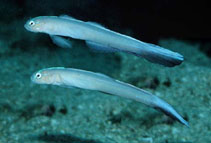| Family: |
Microdesmidae (Wormfishes), subfamily: Ptereleotrinae |
| Max. size: |
8.28 cm SL (male/unsexed) |
| Environment: |
demersal; marine; depth range 12 - 25 m |
| Distribution: |
Eastern Pacific: Mexico (Gulf of California), Costa Rica and Panama. |
| Diagnosis: |
Dorsal spines (total): 7-7; Dorsal soft rays (total): 20-22; Anal spines: 1-1; Anal soft rays: 20-23. This species is distinguished from its congeners by the following characters: a short dorsal-fin (VI-I,20-22), first and second dorsal fins of about equal height; short anal-fin (I,19-22);isthmus with a conspicuous median fold or keel; caudal fin lanceolate with a dusky band on lower caudal rays in adults; a blue or lavender body without other markings (Ref. 75966).
The western Atlantic form, Ptereleotris calliurus, is similar to P. carinata in its more lanceolate tail with dark lower half, but differs from P. carinata in having a variety of other fin markings (vs. absent). |
| Biology: |
Individuals were seen poised 10-20 cm above small mounds encircling the small openings to their burrows. It was also observed in burrows always close to a reef or grouped in small colonies on gently sloping mud-sand bottoms usually hundreds of meters from any rocky substrata. Juveniles were collected with quinaldine from the same burrows as adults they darted into. Often two adults or an adult and one or two juveniles were seen to occupy the same burrow. Individuals when prevented from entering their own burrow, would sometimes swim away rather than enter neighboring burrows (Ref. 75966). |
| IUCN Red List Status: |
Least Concern (LC); Date assessed: 23 May 2007 Ref. (130435)
|
| Threat to humans: |
harmless |
Source and more info: www.fishbase.org. For personal, classroom, and other internal use only. Not for publication.

